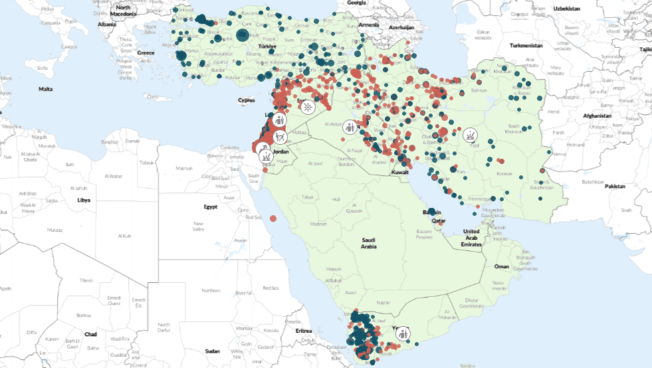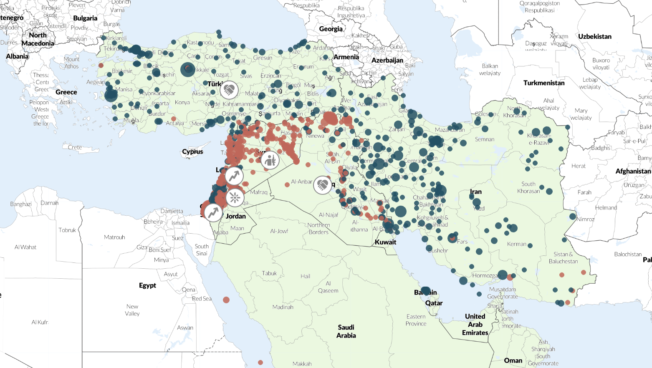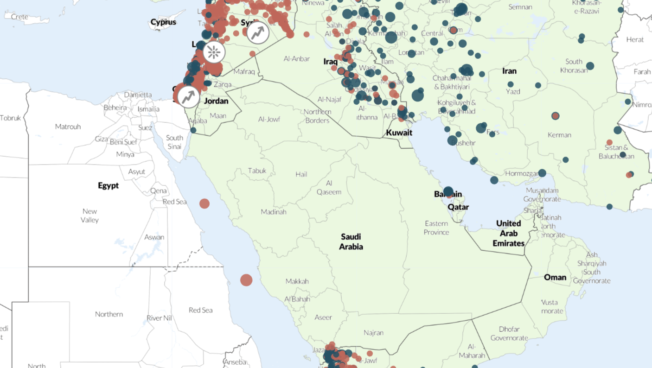Regional Overview
Middle East
February 2025
Posted: 7 February 2025
In this Regional Overview covering January 2025
- Gaza Strip: Violence significantly decreases following the ceasefire and hostage release agreement
- Lebanon: Ceasefire deadline extended amid the IDF’s continued deployment in the south
- Red Sea: Houthis pause attacks in an apparent move to de-escalate in a changing regional scene
- Syria: The Syrian government, Turkey, and the SNA face challenges as they seek to consolidate control
- West Bank: IDF carries out major operations in Jenin, Tulkarm, and Tubas in the north
- Yemen: Houthi confrontations with local tribes escalate in al-Bayda
Gaza Strip: Violence significantly decreases following the ceasefire and hostage release agreement
The 42-day ceasefire and hostage-prisoner exchange agreement between Israel and Hamas, which took effect on 19 January, led to a notable decrease in violence in the Gaza Strip. Prior to the ceasefire, the Israel Defense Forces (IDF) was involved in an average of 27 violent events per day in January. An estimated 1,450 Palestinians were killed in these operations. Following the ceasefire agreement, the number of IDF attacks dropped to less than three per day, with a total of 44 incidents in the remainder of January, leading to at least 16 fatalities, nearly half of which were the result of drone strikes.
Israeli troops have withdrawn from populated areas but remain deployed in the eastern sector of the Netzarim Corridor, the Philadelphi Corridor, and the buffer zone along Gaza’s northern and eastern borders. Internally displaced civilians have been allowed to return to northern Gaza on foot via the al-Rashid coastal road, while vehicles are permitted to use Salah a-Din road, where IDF forces remain stationed near an inspection checkpoint operated by private Egyptian and American companies.1David Gritten, ‘US and Egyptian contractors screening vehicles at Gaza checkpoint,’ BBC News, 27 January 2025 Most lethal incidents after the ceasefire occurred as individuals approached Israeli forces or attempted to cross Netzarim from prohibited areas. These incidents suggest that the IDF continues to monitor the movement of people and vehicles and enforce restrictions despite the withdrawal of troops from the western part of Nezarim.
With the exchange of hostages and prisoners continuing largely as planned, indirect negotiations on Stage 2 of the ceasefire agreement between Hamas and Israel have begun. These discussions aim to reach a permanent truce, with the expectation that Hamas will release all remaining living hostages and Israel will fully withdraw from the Gaza Strip. However, a difficult path lies ahead, with the resumption of fighting remaining a distinct possibility amid a divided government coalition in Israel, as well as potential difficulties Hamas may face in locating and retrieving all living hostages, some of whom might be held by other groups.2Times of Israel, ‘Gaza ceasefire and hostage release updates,’ 14 January 2025 Additionally, there may be a divergence of opinion between Hamas’ political leadership abroad and inside Gaza that would complicate future stages of the deal.3Jon B. Alterman, ‘Israel and Hamas Reach a Ceasefire,’ Center for Strategic and International Studies, 21 January 2025 Recent remarks by US President Donald Trump regarding the US “taking over” Gaza and relocating its population add further uncertainty to the future of the region.4Daniel Estrin and Kat Lonsdorf, ‘Trump says the U.S. will ‘take over’ Gaza and relocate its people. What does it mean?’ NPR, 5 February 2025
For more information, see ACLED Gaza Monitor.
Lebanon: Ceasefire deadline extended amid the IDF’s continued deployment in the south
The ceasefire that went into effect on 27 November between Lebanon and Israel continued to hold in December, despite occasional cross-border IDF attacks. While the number of IDF aerial strikes nearly halved in January, over 40 drone and airstrike incidents were still reported, as Israel maintains that it was targeting Hezbollah’s infrastructure and military facilities. Notably, on 28 January, Israeli drones struck Hezbollah vehicles that Israel claimed were transporting weapons in the southern village of al-Fauqa in Nabatiya. On 31 January, Israeli warplanes targeted several Hezbollah sites in the Baalbek-Hermel and Akkar governorates, including what Israel described as an underground weapons production facility near the Syria-Lebanon border. At the same time, Israel intensified clearance and razing operations in southern Lebanon, with ACLED recording over 160 incidents of property destruction in January — up from 123 in December (for more, see this ACLED Insight).
The scale of destruction in the south of Lebanon has led some to accuse Israel of systematically targeting civilian infrastructure in the border area to complicate the return of displaced residents,5Nazir Reza, ‘The Lebanese Army carried out 500 inspection and dismantling missions targeting Hezbollah installations south of the Litani River,’ Asharq Al-Awsat, 23 June 2025 the majority of whom are thought to be Hezbollah supporters.6Alex Martin Astley, ‘In south Lebanon, fears grow as Israel entrenches its occupation,’ The New Arab, 4 February 2025 Despite the extensive damage, hundreds of Lebanese returned to their villages as the ceasefire agreement’s 60-day deadline came to an end, including in areas where Israeli forces remained deployed. On the deadliest day since the truce began, Israeli troops opened fire on 26 January, killing at least 22 Lebanese attempting to return home in multiple incidents. Israel claimed it had targeted suspected individuals and Hezbollah operatives posing an “imminent threat” to troops operating in southern Lebanon.7Emanuel Fabian, ‘22 killed in south Lebanon as IDF fires on suspects trying to break through to villages,’ Times of Israel, 26 January 2025 Between 26 and 31 January, after Israel secured an extension of the IDF withdrawal deadline until 18 February, ACLED records nearly 40 shooting attacks against civilians in at least 25 villages, primarily in the eastern sector. While the IDF has in the meantime withdrawn from large parts of southern Lebanon, its complete withdrawal by the end of the extension remains uncertain.
Red Sea: Houthis pause attacks in an apparent move to de-escalate in a changing regional scene
The Houthis paused all their attacks against ships in the Red Sea and Israel midway through January in tandem with the ceasefire between Israel and Hamas in Gaza and the new Trump administration’s decision to redesignate the group as a foreign terrorist organization (FTO). The group had been escalating its attacks against US warships and the Red Sea and Israel since December and continued that trend in the first three weeks of January, when it launched nine attacks targeting Israel and six targeting the aircraft carrier USS Harry S. Truman. But following the ceasefire, they announced they would restrict their attacks to target only Israel-registered or Israeli-owned ships and declared they would cease all attacks once the final phases of the ceasefire are completed.8Paul Peachey, “Houthis announce halt to campaign against non-Israeli ships,” TradeWinds, 19 January 2025 Nonetheless, the Houthis did not claim any attacks targeting Israel or ships in the Red Sea — including Israeli ships — for the rest of the month.
Further, on 22 January, the same day the Trump administration officially redesignated the group as an FTO, the Houthis released the crew of the Galaxy Leader vehicle carrier whom they kidnapped in November 2023. The designation could seriously jeopardize the Houthis’ finances and their ability to engage with international actors, which likely played a role in the group’s decision to de-escalate.9Phil Stewart, ‘Trump designates Yemen’s Houthis as a “foreign terrorist organization,”’ Reuters, 23 January 2025 The Houthis used similar tactics in the past, often before the start of diplomatic talks to strengthen their bargaining position (for more see this ACLED report).
The Houthis began attacking ships in November 2023 in response to Israeli military operations in the Gaza Strip and in purported solidarity with the Palestinian population.
For more, see the Red Sea attacks interactive map created as part of the Yemen Conflict Observatory.
Syria: The Syrian government, Turkey, and the SNA face challenges as they seek to consolidate control
A month after Islamist rebel factions led by Hayat Tahrir al-Sham assumed power in Syria and installed a new government, the newly established Syrian military and police forces launched several campaigns to consolidate control across the country. Efforts were especially concentrated in the northwestern regions of Lattakia and Tartus, as well as parts of Rural Damascus and Homs provinces where the new regime had not gained a decisive victory. These areas saw the emergence of a number of anti-regime militias that targeted military and police forces in an attempt to destabilize the regime. In January, ACLED recorded 14 armed clashes between anti-regime militias and police and military forces. Meanwhile, the new Syrian government forces detained dozens of former regime fighters, including fighters who sought reconciliation. At the same time, more than 176 civilians, including former regime fighters, were killed by unknown gunmen.
Elsewhere, the Syrian National Army (SNA) and Turkish forces engaged in violent confrontations with the Syrian Democratic Forces (SDF) along the western banks of the Euphrates River near Manbij in Aleppo province, in an attempt by the SNA to launch an extensive ground operation that would enable it to advance into the strategic town of Ain al-Arab. The ground operation has been stalled by the SNA and Turkish forces’ inability to take control of the strategic Tishrin Dam, which links the two areas and would allow ground forces to cross into the Ain al-Arab area.10The New Arab, ‘280 dead as Turkey-backed SNA battle Kurdish-led SDF for control of Syria’s strategic Tishrin dam,’ 7 January 2025 Consequently, Turkish forces intensified their airstrikes on SDF-controlled areas in Aleppo governorate, with ACLED recording 93 airstrike events in January compared to 24 events in December 2024.
West Bank: IDF carries out major operations in Jenin, Tulkarm, and Tubas in the north
Violence in the West Bank escalated in January, with a 14% increase in incidents involving Israeli forces compared to December. A major operation, dubbed Iron Wall, was launched on 21 January, targeting Palestinian armed groups in the north. At least 44 Palestinians have been killed during the ongoing operation in Jenin, Tulkarm, and Tubas, bringing the total recorded death toll for January to nearly 70. IDF troops have extensively used drones to target militants and have torn up roads to uncover explosive devices. Israeli forces have also demolished numerous homes and residential buildings in the Tulkarm and Jenin refugee camps, forcing most residents to flee.11Awad Rajoob, Mohammad Sio, ‘Israel displaces 5,000 Palestinian families in West Bank offensive since Jan. 21: Officials,’ Anadolu Agency, 5 February 2025
The recent surge in violence reflects a broader trend of intensified Israeli crackdowns on Palestinian armed groups over the past three years, escalating further after the events of 7 October 2023, with Israel increasingly resorting to warlike tactics similar to those used in Gaza. Dozens of new Palestinian armed groups, primarily affiliated with Palestinian Islamic Jihad or self-identifying as al-Aqsa Martyrs Brigades, as well as cells of Hamas operatives, have reemerged in the West Bank since late 2021. These groups have engaged in armed clashes with the IDF, and have increasingly used explosives to target the troops during raids. They have also conducted attacks on Israeli forces stationed in the West Bank, as well as on Israeli settlers and other civilians.
The latest surge in violence and the Iron Wall offensive, which began shortly after the ceasefire deal in Gaza, follows the IDF’s reinforcement and establishment of dozens of new checkpoints across the West Bank, amid fears of rising tensions due to the release of key Palestinian prisoners. The recent forceful operations and security measures may also be politically motivated, given their implications for the survival of the Israeli ruling coalition. Prime Minister Benjamin Netanyahu has offered incentives to Finance Minister Bezalel Smotrich and pro-settlement parties in the government, who have long advocated for the annexation of the West Bank and are now pushing for the inclusion of West Bank security in the country’s “war goals.”12Kareem Khadder, Zeena Saifi and Mostafa Salem, ‘ Jenin mayor likens Israeli military operation to war in Gaza,’ CNN, 3 February 2025
Correction | 25 February 2025: The initial version of this section incorrectly stated that new Palestinian armed groups have emerged since late 2022. It has now been corrected to 2021.
Yemen: Houthi confrontations with local tribes escalate in al-Bayda
In early January 2025, a simmering conflict between Houthi forces and local tribes escalated in the central al-Bayda governorate, where the Houthis enforced repressive measures due to fears of increasing instability linked to intensified US and Israeli airstrikes. As a result of the fighting, al-Bayda recorded the highest number of monthly reported fatalities from tribal disorder across all Yemeni governorates since September 2020.
On 4 January, tribesmen from Hanaka Al Masud, northwest of Radaa, ambushed a Houthi patrol in al-Quraishiyya district, in the northwest of the governorate, injuring two soldiers. While reports differ, it is likely the attack was meant to pressure the Houthis into releasing hostages13Yemen Monitor, ‘The shrewdness of Al Masoud.. How do we understand the uprisings in Radaa against the Houthis?,’ 14 January 2025 taken in 2022.14The area had seen previous security campaigns and confrontations in July 2022, around Khubza village. At the time, the excessive use of force led to the dismissal of al-Bayda’s pro-Houthi acting governor to curb tribal dissent. See Al Mashahd news, ‘Houthi militia announces appointment of Houthi leader to senior position,’ 24 July 2022 In response, the Houthis launched a security campaign in Hanaka Al Masud, framed as a ‘counter-terrorism’ operation against the Islamic State,15Yemeni Security Media, ‘The police of al-Bayda confirms the continuation of the security operation in al-Quraishiyya district,’ 8 January 2025 demanding the handover of the suspects, which led to clashes with locals. From 5 January to 11 January, the Houthis besieged the village and conducted a large-scale military operation, employing tanks, shelling, and drone strikes. The operation resulted in at least 37 reported fatalities among Houthi fighters and locals, around 400 civilians kidnapped, and several buildings damaged and destroyed, including a mosque.
The area relapsed into violence on 20 and 22 January, reportedly resulting in the deaths of another seven Houthi fighters and three civilians. Meanwhile, the Houthis expanded their security campaign to Radaa City, triggering further clashes with the Al al-Hiradh tribesmen. Tribal disorder in al-Bayda more than doubled in 2024 compared to the year prior, with tensions escalating after the Houthis blew up two houses in Radaa in March 2024, killing at least 12 civilians. This excessive use of force drew widespread condemnation, leading Houthi authorities to acknowledge the operation as a mistake.16X @yemensmc2000, 19 March 2024 Al-Bayda, a Sunni-majority governorate in central Yemen, came under full Houthi control in late 2021. Its northwest, once home to Islamist groups, sees rampant dissent and frequent tribal uprisings.
See More
See the Codebook and the User Guide for an overview of ACLED’s core methodology. For additional documentation, check the Knowledge Base. Region-specific methodology briefs can be accessed below.
Links:
For additional resources and in-depth updates on the conflict in Yemen, check our dedicated Yemen Conflict Observatory.







